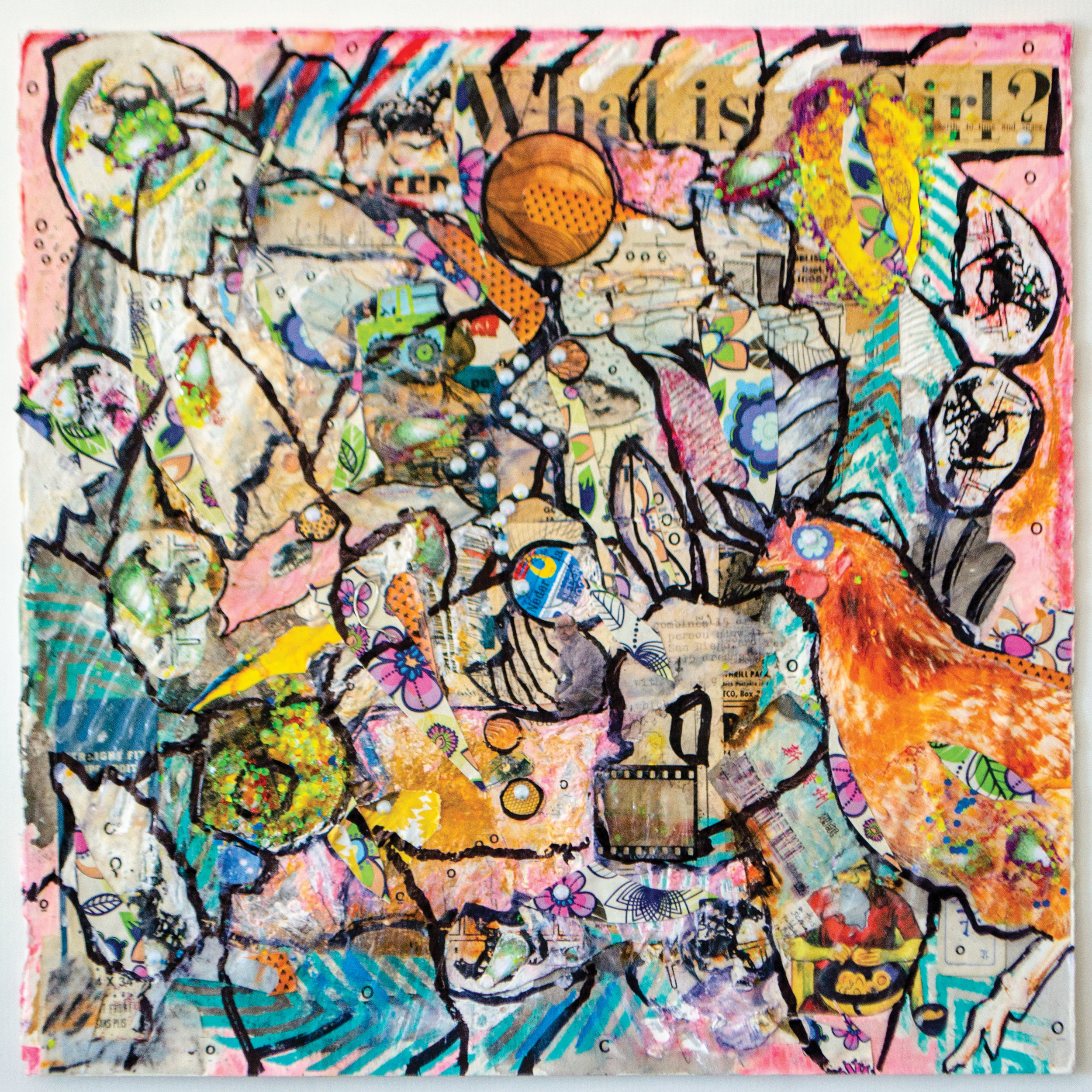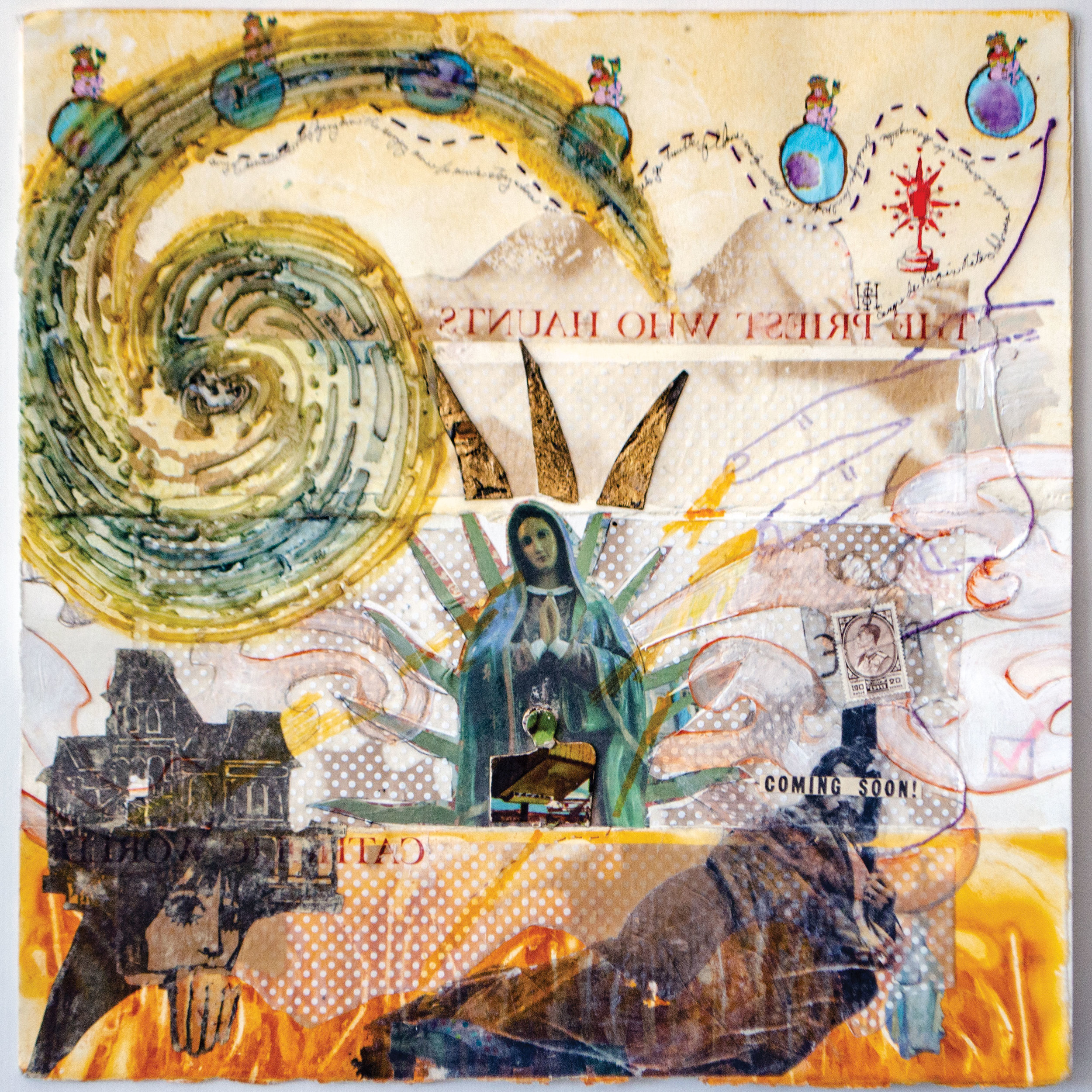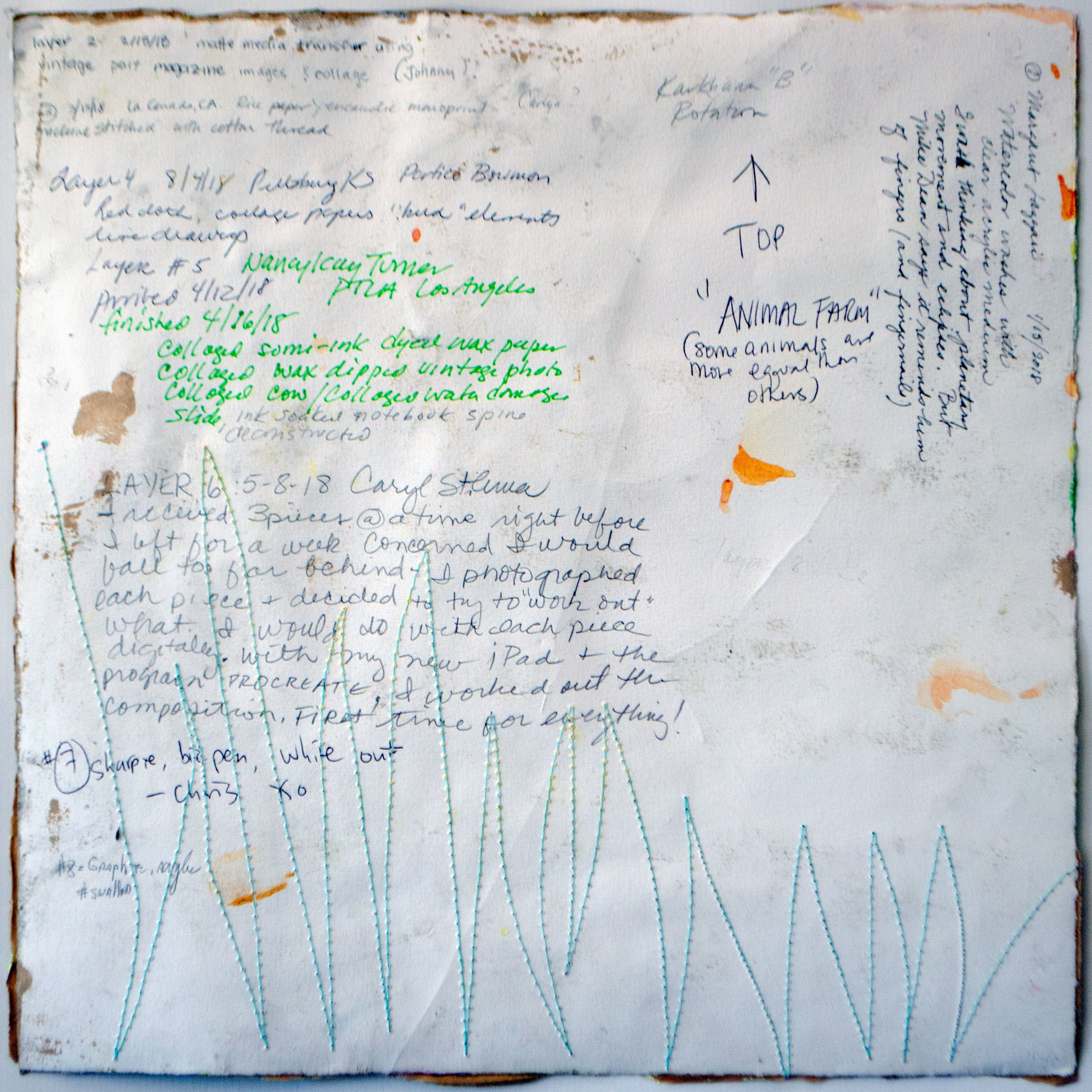“The stereotype of the solitary artist working away in private has dominated the recent history of Western art, but in the end we are social beings. The truth is that artists feed off their relationships with other creative people.”
Jessica Hough, “In The Spirit Of Collaboration”
For most of 2018 I’ve been participating in a group collage exercise. It’s modeled on the Karkhana Project of 2003, where 6 artists worked in discrete succession without preconceived plan.
Karkhana is the Urdu term for the imperial-sponsored workshops that produced manuscripts for Mughal Emperors from the sixteenth until the nineteenth century in what today is India and Pakistan. In these workshops, the production for a single work of art was divided among various collaborating “masters.”
Sometimes the packaging of the artwork itself as it sped or, slogged, through the postal system became archeological as the artists layered paper and text over earlier packages.
“Problem Child”, became extraordinarily dense and almost archeological in structure.
Each artists work experience informs their artistic practice:
Luke Reichle costume designer for film/TV
Chris Russell special education teacher, graphic novel artist
Margaret Lazzari public artist, painter, college professor
S. Portico Bowman novelist, college art professor
Johnny Fox gallery preparator, sculptor
Carlyn Clark textile designer, fiber artist
Nancy Kay Turner mixed media artist, art critic
Caryl St. Ama painter/encaustic, college art professor
Geographically the artists were in London, England; Pittsburg, Kansas; Los Angeles, California; and Alberta, Canada.
Looking at the front of the collage, you’d never know what was beneath “Round Up Deconstructed”
As life intervened, some members had to move away from Los Angeles and the works traveled from LA to NY, to Vancouver, to Kansas, to Hawaii, to San Diego and to Alberta, Canada.
“Artificial Intelligence”, mixed media, 15” x 15”S. Portico Bowman, Carlyn Clark, Johnny Fox, Margaret Lazzari, Luke Reichle, Chris Russell Russell, Caryl St. Ama, Nancy Kay Turner
Before figuring out the structure of this project, Nancy Kay Turner and Margaret Lazzari collaborated on six works on paper casually mailing each work to each other with no particular timeline. These works went back and forth over a year. There was another Karkhana precursor with Caryl St. Ama, Carlyn Clark, Luke Reichle, S. Portico Bowman and Nancy Kay Turner. In that series (called “K1”), Portico did all the first layers and sent them out: therefore, this particular series had an internal compositional structure that easily became identifiable as landscape.
Nancy Kay Turner describes the unfolding process: “once we had eight artists we had to establish a specific rotation (which later circumstances required that we alter) based on an alphabetical order, a set of monthly deadlines, and a few rules. It was decided by all to keep the boundary sacrosanct at fifteen inches square and to stay two-dimensional - mostly because of concerns that the work would get damaged or prove too expensive to send. For most of the participants the process was surprising and challenging, especially because of the monthly deadline. We tabled concerns over ownership and possible sales to be discussed upon completion of the project.”
“Hang Up”
“I found the process to be freeing”, concluded Margaret Lazzari. “I was almost never in control of what I received and almost never in control of the final product. Because of the lack of ownership, I took chances that I realize I should take more often with my own work…I found myself thinking more about form than meaning, and was willing to just let the meaning come through once the marks were made”.
“Ha Ha Hat Trick”
“Problem Child”
“Perfect Camel”
“Spiritual Dilemma”
“Money Laundering”
“Money Laundering”, prior to the final layer
For Margaret Lazzari “working on the third to the fifth layers was the best part”. Here is
Dark Matter, 15”x15”, mixed media: S. Portico Bowman, Carlyn Clark, Johnny Fox, Margaret Lazzari, Luke Reichle, Chris Russell Russell, Caryl St. Ama, Nancy Kay Turner
Some works, such as “See Father Pray”, clearly show each artist’s layer and decisions.
In January 2018, a group of 8 artists, corralled and inspired by Nancy Kay Turner, began a new permutation of the project. Each artist created the first layer on two surfaces and then sent them on their way. Eventually everyone worked on all 16 pieces (though one went astray and was never found). The artists were asked to participate because they were connected to someone in the group – either as a teacher, mentor, colleague or former student. The artists chosen all have diverse art practices that encompass drawing, mixed -media, digital imagery, painting, and sculpture.
The Karkhana model is particularly exciting in art-making today as artists across divides (gender, age, geography) can collaborate to produce artworks that are at one point in time uniquely theirs, but by the end of the process the works are completely hybrid. What was historically an actual physical workshop with many skilled workers in the same place became instead a loosely defined collaborative network.
Notes on the back of each piece capture a bit of the artist’s thinking
Each artist had a different response to the challenges posed with this new way of working.
Johnny Fox noted, “I found the entire concept to be quite intriguing. Responding to the disparate approaches and contradictory styles each artist employed in order to create this body of work was immensely enjoyable and challenging”.
“Karkhana collaboration is a space in which to drop pieces of myself. Traces of what I believed to be essential are covered over, or torn away and I’m forced to reconsider my attachments,” S. Portico Bowman.
The orientation changed on some works as is evident on the paper trail on the back. “Round Up Deconstructed was spliced, flipped and put back together with plaster tape.
Caryl St. Ama related, “I approached the Karkhana project with a bit of hesitation. I spent a long time looking at the work and finally developed a technique that worked for me by photographing each piece before working on it in Procreate on my Ipad”.
The biggest challenge for Nancy Kay Turner was “that I was more ‘product’ oriented than I had imagined. My desire was to fix what I saw as compositional issues, which may be the result of my decades-long career as both a critic and a teacher. I often employed my Iphone as a tool to take pictures of various solutions before committing to one.”
“Oh Daddy, Oh Daddy”
Chris Russell, who has long been engaged with collaborative mail art exchanges, discovered that “the process is always interesting and new and it tends to bring out very different approaches, and even use of different media than any solo art practice. The Karkhana project created by Nancy Turner has developed into something strange and wonderful in these expansive mail exchanges. For me, this was, by far, the most challenging mail art collaboration I’ve been involved with.”
“The Postman Rings Twice”
Participants were allowed to erase, remove, or paint over earlier marks if necessary for the composition.
Each mixed-media piece has a diaristic element as every artist was instructed to write on the back and to note the date of arrival, and when they finished it, and of course, to sign the back. Some artists added notes about mood or a particular emotional trial they were going through.
Artists were instructed to take a before and after picture of every work received and send it to S. Portico Bowman who created a website especially for this conceptual project. Please visit www.karkhanaproject.weebly.com to see the evolution and more, detailed images of the project.
Many of the artists discussed how the process shifted considerably depending on which layer they were working on.
“Artificial Intelligence”
Luke Reichle, who moved to Vancouver, Canada for work, noted that the project was “a lesson in collaboration, partnership, and international shipping charges. It turns out that Canada is an actual foreign country!” but concluded,
“Customs, duties and brokerage fees…pricey.
Getting to work with this group of artists…priceless.”
I did the final layer on Money Laundering. I tore the piece in half, taped it back together and added historical references to commerce from around the world.
For me, “in the beginning the process was quick but as the layers built up it became a much more thoughtful and labored undertaking. It was as if I was having a wordless conversation with each of the artists who had worked before me. Sometimes my response was strictly to the composition of the piece, and other times the work evoked a memory that guided what I did. In the end, I found that the process made me think about what I put on the paper in a different way than I have before.”
”Men in White” after Margaret finished layer 4.
“Men in White” after all 8 layers
Just like in real life, some pieces were easy to work on while others were nearly impossible or impassable.
The creation of this conceptual body of work echoed a solo creative practice, which is filled with doubts, anxieties, exhilaration, surprise, fear, and ultimately joy.
In the end, everyone came through.
We already miss the chance to work together and are considering our next Karkhana collaboration.





















